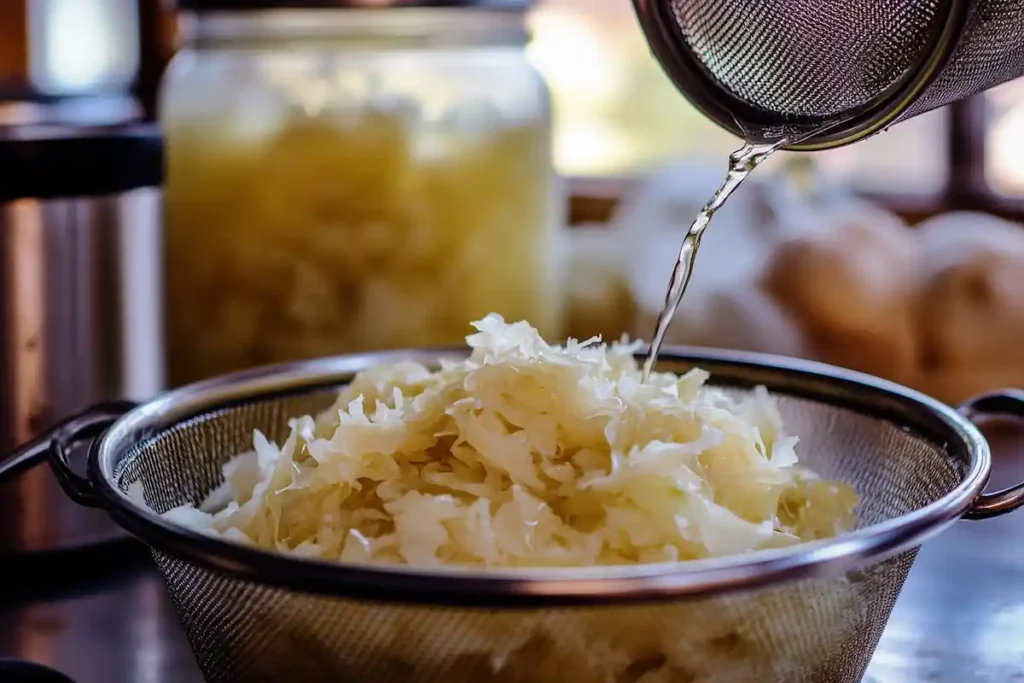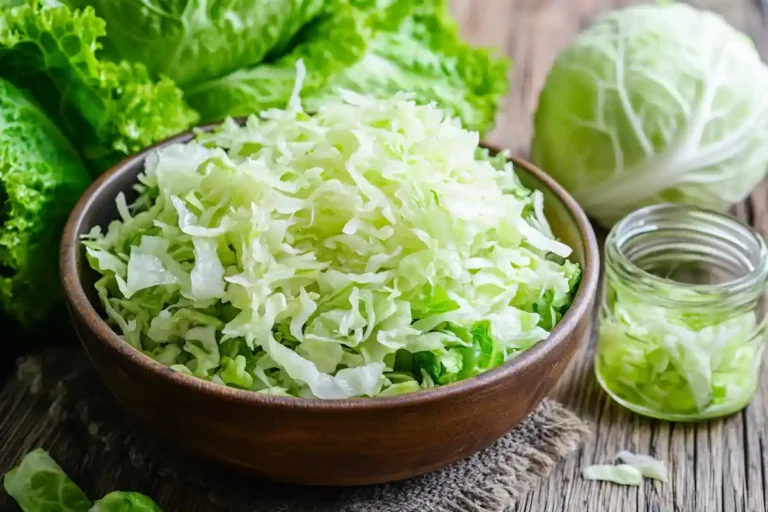Introduction
Sauerkraut is undoubtedly one of the most beloved fermented foods, chiefly because it offers a tangy flavor while supporting gut health through its probiotic-rich profile. Certainly, people around the world have enjoyed pickled cabbage for centuries, and it remains popular due to its healthy digestion benefits and vitamin content. Comparatively, it stands out among other fermented vegetables for its simplicity and ability to boost both ordinary and extravagant meals.
Eventually, the question, “Should you drain sauerkraut before cooking?” keeps popping up. Notwithstanding sauerkraut’s appeal, many home cooks wonder if removing the brine is necessary, lest their recipes become overly sour or salty. Hence, there is a natural urge to clarify when to keep that sauerkraut brine intact and when to discard or rinse it.
Equally important, understanding the rationale behind sauerkraut preparation helps preserve its lactic acid bacteria and flavor components. Undoubtedly, a well-informed approach will ensure that your sauerkraut turns out both nutritious and flavorful in every dish. Thus, exploring different draining methods, discovering possible benefits or drawbacks, and knowing the times when draining is ideal (or not) will empower you to create versatile, probiotic-rich meals. Accordingly, let’s dive in and learn more about cooking with sauerkraut.
1. Understanding Sauerkraut
What Is Sauerkraut?
Initially, sauerkraut is simply shredded cabbage that has undergone a fermentation process powered by lactic acid bacteria. These helpful bacteria feed on the natural sugars in cabbage, therefore producing that signature sour taste most of us love. Historically, sauerkraut’s origins are traced back to ancient China, although it gained vast popularity in Eastern Europe, Germany, and beyond. Evidently, it has endured through centuries as a staple in many cultures.
Brief History and Origin
Formerly, it was cherished for its long shelf life and robust taste, particularly during harsh winters. Moreover, sailors stored sauerkraut on ships to prevent scurvy, i.e., vitamin C deficiency. Correspondingly, its ability to remain fresh for extended periods made it a treasured resource before modern refrigeration existed.
Nutritional Benefits of Sauerkraut
Surely, one of sauerkraut’s key perks is its probiotic-rich nature, which supports gut health and healthy digestion. Additionally, sauerkraut contains notable levels of vitamins C and K, not to mention dietary fiber that promotes a balanced internal environment. Altogether, these nutrients help bolster your immune system, especially when combined with a well-rounded diet.
Nutritional Content (Per 100g)
| Nutrient | Amount | Daily Value (%) |
|---|---|---|
| Calories | 19 kcal | 1% |
| Protein | 0.9 g | 2% |
| Fat | 0.1 g | 0% |
| Carbohydrates | 4.3 g | 2% |
| Dietary Fiber | 2.9 g | 12% |
| Sugars | 1.8 g | — |
| Vitamin C | 14.7 mg | 16% |
| Vitamin K | 13.6 mcg | 11% |
| Sodium | 661 mg | 29% |
| Calcium | 30 mg | 3% |
| Iron | 1.5 mg | 8% |
Key Nutritional Highlights
- Low in Calories: At just 19 kcal per 100g, sauerkraut is an excellent choice for calorie-conscious diets.
- Rich in Probiotics: The fermentation process enhances gut health and supports digestion.
- High in Fiber: With 2.9g of dietary fiber, it aids in maintaining a healthy digestive tract.
- Packed with Vitamins: Notably, it provides significant amounts of Vitamin C and Vitamin K, essential for immunity and bone health.
- Contains Sodium: While sauerkraut is salty, this can be managed by draining or rinsing, depending on dietary needs.
The Role of Sauerkraut in Cooking
Contrarily to what some might think, sauerkraut goes beyond just a side for sausages. Specifically, it’s perfect in soups, stews, and sandwiches because of its remarkable flavor and texture. Secondly, the way you cook or heat it can affect its tanginess—mellowing or intensifying it depending on the method. Therefore, whether you bake it, sauté it, or toss it raw, you can easily incorporate this versatile, pickled cabbage into your routine.
2. The Debate Around Draining Sauerkraut
Should You Drain Sauerkraut Before Cooking?
Comparatively, many home chefs struggle with whether draining sauerkraut is an absolute must. Nonetheless, there are some valid reasons to do so. Firstly, draining helps balance flavors by lessening the sour taste of the brine. Secondly, it can reduce excessive saltiness or tang that may overwhelm milder recipes. Henceforth, those seeking a more subtle taste frequently drain their sauerkraut for harmony among flavors.
Nevertheless, draining leads to certain disadvantages. Undoubtedly, the brine you pour off contains probiotic-rich liquids vital for gut health. Despite this, you might choose to preserve some brine by using it in stocks or sauces. However, removing too much liquid can diminish that trademark tang many people cherish.
The Impact of Not Draining Sauerkraut
Occasionally, un-drained sauerkraut creates over-acidity, especially in delicate dishes like light soups. Hence, certain ingredients might get overshadowed or masked by the pungent tang. But, in hearty stews or robust recipes, that extra zing can act as a flavor booster. Thereupon, it’s all about matching the dish’s intensity to sauerkraut’s level of sourness.
When to Drain and When Not to Drain
Certainly, mild soups or gently flavored side dishes benefit from draining because you avoid turning the whole pot into a sour extravaganza. For instance, if you’re making a potato soup, removing some of the brine can keep it balanced. Contrarily, with something like a hearty stew, un-drained sauerkraut comparatively heightens the savory profile, delivering complexity and richness.
Similarly, you can incorporate un-drained sauerkraut into sandwiches that benefit from a bold bite, such as a turkey Reuben. Afterwards, you might thank yourself for keeping that flavor intact, because the brine saturates the bread and complements the proteins. Therefore, whether to drain or not is markedly situational. Certainly, understanding how acidity impacts your recipe leads you to better decisions in the kitchen. Hence, let’s move on to a thorough guide on sauerkraut preparation, so you can be sure you’re treating these fermented foods in a way that suits your palette and nutritional goals.
3. Step-by-Step Guide to Preparing Sauerkraut
How to Drain Sauerkraut Properly

Firstly, choose a fine-mesh strainer that can hold the amount of sauerkraut you plan to use. Then, place the sauerkraut in the strainer over a bowl. Gently press down with the back of a spoon or your clean hands to squeeze out the excess liquid. Afterwards, let it rest for a few minutes to ensure most of the brine drips away. During this process, you might collect the sauerkraut brine in the bowl, because it’s loaded with lactic acid bacteria. Notwithstanding the urge to discard it, you can store it for later use.
Forthwith, transfer the drained sauerkraut to a container or directly to your recipe. Certainly, if you want to retain healthy digestion benefits, save that liquid. Consequently, keep it in a sealed jar in the refrigerator for about a week or two, monitoring its aroma and color to confirm freshness.
Tips for Preserving the Sauerkraut Liquid
Surprisingly, sauerkraut brine can act as a secret ingredient in dips, salad dressings, or even marinade solutions for chicken. Also, adding a splash to stews or casseroles can liven up the entire dish. Shortly, you’ll realize that you haven’t wasted a single drop of tangy goodness.
Alternative Methods: Rinsing Sauerkraut
Basically, rinsing sauerkraut is more intense than draining since you use water to wash away the acidity and salt. However, you also rinse away many of its beneficial probiotics. Consequently, you should use rinsing only when a recipe calls for minimal sourness, i.e., extremely delicate flavors that might be overpowered by the brine. Altogether, keep in mind that rinsing can significantly dull sauerkraut’s signature taste and reduce its probiotic-rich qualities.
When Rinsing is Appropriate and Its Effects
Explicitly, if you’re cooking for someone sensitive to acidity or salt, rinsing might be a straightforward solution. Nevertheless, it’s wise to taste as you go, adding a pinch of salt or a twist of lemon if the flavor becomes too bland. Despite the reduced tang, the cabbage will still provide a satisfying crunch and texture to the dish. Equally vital is to pat the sauerkraut dry after rinsing to prevent watering down your recipe.
Using Sauerkraut Liquid (Brine) in Cooking
Evidently, the leftover brine holds a wealth of nutrients, particularly the beneficial bacteria important for gut health. Hence, never overlook the possibility of using it as a base for soups or as a flavorful marinade. For instance, blending a small amount into your next veggie stir-fry sauce can add a bright, unexpected zing.
Afterwards, store the brine in an airtight jar, and keep it refrigerated to maintain freshness. Nevertheless, watch out for any unusual smell or mold, discarding it if it seems off. Altogether, these practical steps will help you optimize your sauerkraut preparation method. Therefore, let’s move forward and explore delicious recipes and tips on how to seamlessly incorporate cooking with sauerkraut into your daily routine.
4. Recipes and Cooking Tips
Simple Recipes for Cooked Sauerkraut
Sautéed Sauerkraut with Onions and Apples
- Ingredients:
- 2 cups of sauerkraut (drained or un-drained, as preferred)
- 1 tablespoon olive oil
- 1 medium onion, thinly sliced
- 1 apple, peeled and chopped
- 1 teaspoon caraway seeds (optional)
- Salt and pepper to taste
- Firstly, heat the olive oil in a skillet over medium heat.
- Then, add the sliced onions and sauté until they turn translucent.
- Afterwards, toss in the chopped apples and stir gently for about 2 minutes.
- Next, add the sauerkraut. If it’s un-drained, be cautious of the extra liquid.
- Meanwhile, sprinkle the caraway seeds if desired, stirring continuously to mix all flavors.
- Eventually, season with salt and pepper, cooking for another 5–10 minutes, until everything melds together.
- Finally, serve hot as a side dish or topping.
Comparatively, this recipe is sweet, tangy, and altogether satisfying. Moreover, it pairs wonderfully with roasted chicken or grilled veggies.
Sauerkraut and Sausage Stew
- Ingredients:
- 3 cups sauerkraut (partially drained)
- 1 tablespoon vegetable oil
- 1 medium onion, chopped
- 2 cloves garlic, minced
- 1 lb chicken sausage, sliced
- 2 cups vegetable broth
- 1 teaspoon paprika
- Salt and pepper to taste
Step-by-Step Instructions:
- Initially, warm the oil in a deep pot over medium heat.
- Secondly, sauté the onion and garlic for around 3 minutes.
- Then, stir in the sliced sausage and continue cooking until it browns slightly.
- Afterwards, add the sauerkraut, paprika, and vegetable broth.
- Thereafter, bring the mixture to a gentle simmer, allowing the flavors to meld for 15–20 minutes.
- Later, taste and adjust salt and pepper accordingly.
- Finally, serve hot with crusty bread or steamed rice.
Incorporating Sauerkraut into Everyday Meals
Likewise, you can add sauerkraut to sandwiches or salads to deliver that tangy flavor. Significantly, it pairs well with proteins like chicken, turkey, or fish. Also, mix it into grain bowls for an extra zing. Therefore, the possibilities are endless as long as you strike the right balance of flavors.
5. Addressing Common Questions (FAQs)
Should You Drain Sauerkraut Before You Cook It?
Undeniably, context matters. If you want a milder flavor or are working with subtle ingredients, draining is significantly beneficial. However, if you’re craving robust tang or preparing a deeply flavored stew, you might skip draining for that sour taste punch. Hence, let your recipe guide your choice.
What Happens If You Don’t Drain Sauerkraut?
Occasionally, leaving the brine can lead to a pronounced acidity that some people find overwhelming. Nevertheless, this tang may be desirable in certain dishes, e.g., hearty soups or stews that can handle bold flavors. Comparatively, strong flavors can handle the brine more gracefully.
Should You Drink the Liquid in Sauerkraut?
Evidently, the liquid is probiotic-rich and can benefit your digestive system when consumed in moderation. Still, it’s quite salty and tangy, so proceed with caution if you have dietary restrictions. Explicitly, start with small amounts to see how your body responds. Additionally, some individuals add sauerkraut brine to their daily health routine by sipping a tablespoon or mixing it into a morning smoothie.
Why Do People Drain Sauerkraut?
Primarily, it’s about lowering salt content and reducing the sharp tang. Despite sauerkraut’s countless fans, some might find it too acidic. Hence, draining or rinsing helps adapt the intensity to personal preference. Thereafter, certain cuisines also use different variations of drained or un-drained sauerkraut based on long-standing traditions. Undoubtedly, it’s always wise to sample your sauerkraut before deciding.
6. Tips for Storing and Handling Sauerkraut
Proper Storage Techniques
Obviously, once you open a jar or pack of sauerkraut, it needs refrigeration. Moreover, try to submerge the cabbage under its brine to maintain freshness. Whenever the brine level drops, the exposed sauerkraut can spoil faster. Hence, keep it sealed tight in a container and always use clean utensils to avoid contamination.
Signs of Spoiled Sauerkraut
Doubtedly, not all off-smells indicate spoilage, although mold or foul odors definitely warrant discarding. Similarly, if the texture turns slimy or the color changes drastically, err on the side of caution and throw it out. Comparatively, fresh sauerkraut should maintain a firm texture, light color, and tangy flavor aroma.
Safety Tips for Handling Fermented Foods
Certainly, your hands and tools should be squeaky clean when you handle sauerkraut. Therefore, always wash cutting boards, knives, and containers thoroughly before transferring fermented products. Correspondingly, keep the lid on tight to prevent any cross-contamination. Undoubtedly, practicing these steps helps preserve probiotic-rich benefits while preventing unwanted bacteria from spoiling your batch.
Conclusion
Sauerkraut’s popularity rests on its ability to provide healthy digestion perks, deliver a tangy flavor, and fit seamlessly into countless recipes. Surprisingly, this pickled cabbage proves that fermented vegetables can be both delicious and nutrient-dense. However, the question of draining or not draining remains an important factor that directly impacts the taste, texture, and probiotic-rich qualities of this versatile ingredient.
Therefore, your personal preference and recipe style should guide whether you decide to keep or remove the sauerkraut brine. Because some dishes benefit from a milder result, you might opt for draining or even rinsing sauerkraut. Conversely, robust stews and bold creations thrive on the extra zing of un-drained sauerkraut, capturing all that lactic acid goodness.
Altogether, taking the time to experiment with different approaches can open up a world of flavor possibilities. Surely, you can preserve beneficial probiotics, harness subtle tanginess, or amp up your meal with intense sourness. Thus, you control the outcome, ensuring your culinary adventures remain both exciting and healthful. Finally, enjoy discovering all the ways sauerkraut recipes can transform your kitchen into a playground of taste and nutrition.

